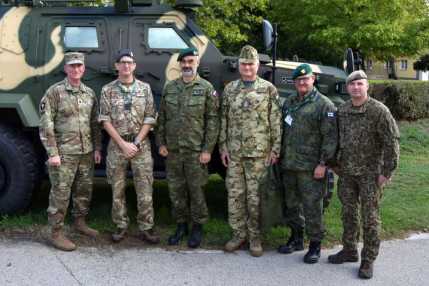NATO monitors at Exercise ADHU 25
Text: Ágnes Szabó | Photo: HDF Joint Operations Command | 12:39 October 8, 2025At the request of the Chief of the HDF Defence Staff, a monitor team of NATO Allied Joint Force Command gathered strategic and execution-level lessons learned on country defence Exercise Adaptive Hussars 2025.

In summing up the visit, Colonel József Csősz, the head (and Hungarian member) of the delegation from Allied Joint Force Command Brunssum (JFCBS), the Netherlands said that NATO has been monitoring the exercise series Adaptive Hussars (ADHU) since 2023. Already in the planning phase, it was clear to them that the direction and the objective of ADHU is in harmony with JFCBS’s efforts. The colonel added that they had chosen a very busy week on purpose, so that they can travel to NATO organizations operating in Hungary, and gain first-hand experience of the way the objectives of ADHU 25 are being implemented at the HDF Defence Staff and the operational commands.
Colonel Csősz pointed out that the name of the exercise, Adaptive Hussars says it all: adaptation is an attitude of primary importance in today’s dynamically changing environment, where we live. One of the stops of their visit, the HDF Joint Operations Command (HDF JOC) – a new, medium-level command of the Hungarian Defence Forces established this year – will operate as partner command of the JFCBS in the future, and the two organizations have established contact in person in a special situation, since the HDF JOC itself is evaluating its capabilities during the exercise.
The colonel quoted previous JFCBS director General Guglielmo Luigi Miglietta’s motto: “We are shaping the change”, noting that the new commander, General Ingo Gerhartz has also adopted this creed. Colonel Csősz highlighted that all this is in line with the message of ADHU 25, as the testing of Hungarian national plans and their harmonization with NATO’s plans is a key objective of the exercise.
Another objective in line with NATO’s priority is called “comprehensive approach” in Alliance terminology. Exercise ADHU 25 is special because in addition to the joint-force-level, it involves civilians and the public administration in the tasks as well. For this reason, the challenges encountered by this year’s exercise and its results, which may be utilized in the future are important lessons learned at the international level, too. The problems of the present have been built in the scenario, so that NATO guidelines were taken into consideration in their solutions, although they were adapted to the Hungarian situation and Hungarian priorities. Thus, they have created a situation that almost completely mirrors today’s reality and yet remains fictitious. From a professional point of view, it is especially important to note that all this has offered an opportunity to examine – naturally, under fictitious circumstances – what steps precede a conflict, how prevention and deterrence are working, how the Hungarian Defence Forces are providing assistance and with whom they are cooperating in this transitory situation – on the national and the international levels.
During its stay in Hungary, the monitor team paid a visit to Headquarters Multinational Division Centre (HQ MND-C), a regional NATO command element operating as part of the NATO Force Structure, and to the NATO Force Integration Unit Hungary (NFIU HUN). The team members held two rounds of professional discussions with the Operations Directorate of the HDF Defence Staff and the joint leadership of the HDF Defence Staff Public Affairs Directorate and the HDF Defence Staff Cyber and Information Operations Directorate. The topic of the first was operational planning, whereas the second discussion centered on the strategic communication of the Hungarian Defence Forces and the communication concept of the exercise, its fundamental principles and the lessons learned so far.
The delegation also visited the Hungarian Defence Forces Cyber and Information Operations Centre, where its members attended a professional forum to get informed about a special, rapidly and continuously evolving, important capability of the Hungarian Defence Forces, which encompasses some main topics such as innovation, the proper use of artificial intelligence, cyber security, civil-military cooperation and information operations as well as the analysis of the information domain. The colonel highlighted that the parallel running of cyber and information operations within the same organization is unique even at NATO level.
The monitor team was accompanied by a media team on the exercise. During the few days spent in Hungary, the members of the latter visited SOF soldiers in Sármellék and reservists in Nagykanizsa. They were introduced to the helicopter fleet in Szolnok, and to the NASAMS subunit in Győr. Besides, they attended a capability display at Vezseny, where they filmed the wet gap crossing operation.
In summing up the visit, Colonel Csősz underlined that we can expect even closer cooperation between the NATO JFCBS and the Hungarian Defence Forces, especially in the fields of planning and conducting exercises – because, as he put it, “cooperation is the basis of Alliance strength”.